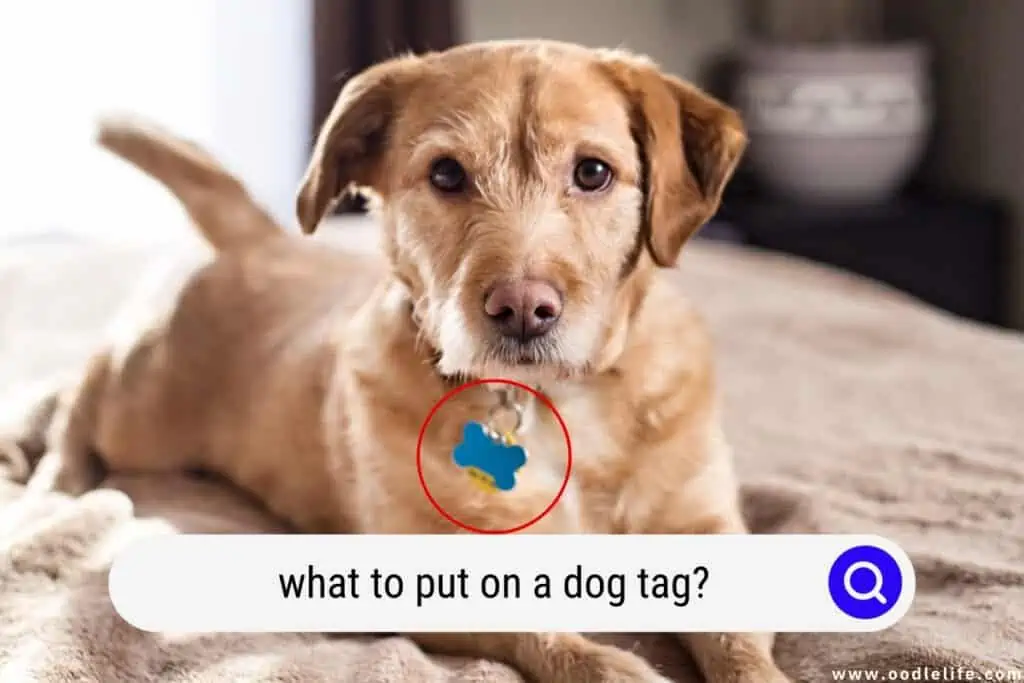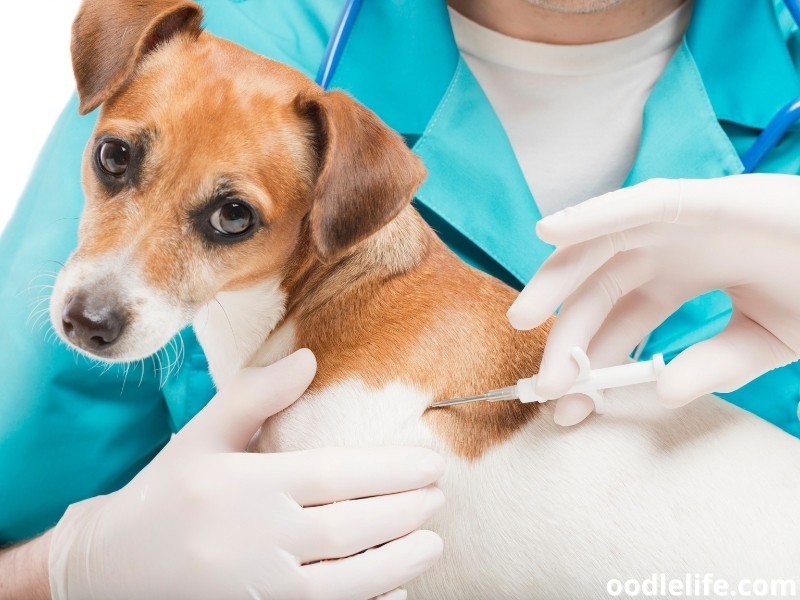What To Put On a Dog Tag? (2024 Advice)
If you’re a dog owner, chances are you’ve considered getting your dog a dog tag. Dog tags serve several important purposes and can be lifesavers if your dog gets lost.
First and foremost, a dog tag helps to identify your pet. If your dog is found by someone who doesn’t know you, a quick glance at the tag will let them know who to call.

Dog tags also provide critical information in the event of an emergency. For example, if your dog is injured and taken to the vet, the staff can quickly identify him and contact you.
Finally, dog tags can help reunite lost dogs with their owners. Thousands of dogs are lost or stolen every year, but many are returned to their rightful owners thanks to the information on their tags.
For all of these reasons, it’s clear that every dog should have a dog tag.
My Dog is Microchipped – Does He Still Need a Dog Tag?
Many dog owners choose to have their pets microchipped, and for good reason. Microchipping provides a permanent form of identification that can help reunite lost dogs with their families.
However, some people believe that microchipping negates the need for a dog tag. After all, why would you need a tag if your dog already has a microchip?
There are a couple of reasons why a dog tag is still important, even if your pet is microchipped.
- First, a tag provides immediate information to anyone who finds your dog. A microchip will only provide information if it is scanned by a vet or animal shelter, but anyone can read a tag.
- Second, a tag is less likely to fail than a microchip. Although microchips are generally reliable, they can stop working if they become damaged or dislodged. A tag, however, will continue to work as long as it remains attached to your dog’s collar.
For these reasons, it’s important to ensure that your dog always wears a tag, even if he is microchipped.

What Should Be Included on a Dog Tag?
A dog tag is a small, metal tag attached to your dog’s collar. The purpose of a dog tag is to provide basic information about your dog in case they become lost. Most dog tags will include the dog’s name, their owner’s contact information, and any critical medical information.
Including this information on a dog tag can help to ensure that your dog is quickly reunited with you if they ever become lost.
Dog Parent’s Address
Dog tags are a must-have for any pup, and there are a few good reasons why your dog’s address should be included on his tag. First of all, it’s a safety measure.
If your dog ever gets lost, having his address on his tag will increase the chances that he’ll be returned to you.
Secondly, it can help identify your dog if he’s ever involved in an accident. If someone finds your dog and takes him to the vet, the vet will be able to contact you if your dog’s tag has your address on it.
Finally, including your address on your dog’s tag is just good etiquette. If your dog ever ends up on someone else’s property, they’ll be able to contact you quickly and let you know.
So make sure your dog’s tag has all the important information – including his address!

Dog Parent’s Contact Info
Every dog owner should make sure that their contact info is on their dog’s tag. That way, if the dog ever gets lost, whoever finds him can easily get in touch with you and return him safely.
Many people might think their dog will never get lost, but it can happen to even the best-behaved pooches. Dogs are curious creatures, and they often follow their nose into danger.
That’s why it’s essential to have your phone number on your dog’s tag – just in case he wanders off.
So put your mind at ease and put your contact info on your dog’s tag today!

Your Dog’s Name
A dog’s name should be on his dog tag for many reasons.
- First, it is a way of identifying the dog if he gets lost. If someone finds a dog without a name tag, they may be unable to track down the owner.
- Second, a dog with a name tag is more likely to be returned to his owner if he does get lost.
- Third, a dog’s name on his tag can help show that he is loved and cared for. People are more likely to interact with and be kind to a dog who has a name.
- Lastly, having a dog’s name on his tag can help build a bond between owner and pet. Seeing the dog’s name daily can remind the owner to give him some attention and love.
Ultimately, there are many good reasons to put a dog’s name on his dog tag.

Your Name (optional)
A dog tag is an essential piece of equipment for any dog owner, as it helps to ensure that your dog can be returned to you if they ever become lost. Most dog tags will include your dog’s name and your contact information, but you may also choose to include your surname.
There are a few good reasons for doing this.
- First, if your dog ever ends up in a pound or shelter, staff will be able to identify them as yours more easily.
- Second, if your dog is found by someone who doesn’t know you, they may be more likely to return the dog if they see that it belongs to a family.
- Finally, including your surname on the tag can help to provide an extra level of identification in case your contact information changes.
Ultimately, it’s up to you whether or not to include your surname on your dog’s tag, but it’s definitely something worth considering.

Your Dog’s Medical Info
A dog’s medical information should be put on his dog tag for a few reasons.
- First, if your dog were ever to get lost, the finder would know what kind of medical care he needs and how to get in touch with you.
- Second, if your dog were ever to have an emergency while you were away from home, the first responders would know what medical conditions he has and how to best care for him.
- Finally, many veterinarians now offer discounts to clients whose dogs are up to date on their vaccinations and have their rabies tags – so it’s a good way to save a little money!
All in all, there are many good reasons to ensure your dog’s medical information is up to date and on his dog tag.

Your Dog’s Microchip Info (optional)
Microchipping your dog is one of the smartest things you can do as a pet owner. Not only does it give you peace of mind in knowing that your dog can be identified and returned to you if they ever get lost, but it can also help reunite stolen dogs with their rightful owners.
And while most people are aware of the benefits of microchipping, many don’t realize that engraving “microchipped” on your dog’s tag is just as important. So if your dog is found by a good Samaritan or animal control officer, they’ll know to look for a microchip.
And if your dog is stolen, the thief will likely remove the tag before taking the dog to a new home.
So by engraving “microchipped” on your dog’s tag, you’re giving yourself and your pet the best chance of being reunited if they’re ever lost or stolen.

Personal Message on Your Dog’s Tag (optional)
Many people think that the only reason to have a dog tag is for their name and phone number in case they get lost.
But what if your dog does more than just run off? What if they get hurt and can’t get back to you on their own? In these cases, it’s important to have a personal message engraved on your dog’s tag that will let strangers know how to help.
For example, you could include a message like “Please call my Dad and Mom” or “If I’m alone, I’m lost.”
This way, if something happens to your dog, you can rest assured knowing that they’ll be taken care of until you can get to them.

Pros and Cons of a Dog Tag
There are a few pros and cons to consider before you put a dog tag on your pup.
Pros
One pro is that if your dog gets lost, their tag will help them be identified and returned to you.
Another pro is that tags can be a fun way to show off your dog’s personality – you can choose a fun or clever design or even get one engraved with their name or a special message.

Cons
A con of dog tags is that they can make noise when your dog moves around, which some people find annoying.
Another potential downside is that they can get caught on things, which could lead to your dog getting injured or the tag getting damaged.
Ultimately, whether or not you decide to put a dog tag on your pet is up to you – just weigh the pros and cons and make the best decision for you and your furry friend!

Final Thoughts
Your dog should always have some form of identification, whether a traditional collar and tags or a microchip. While microchips are permanent and can’t be lost, there are several advantages that dog tags have over them.
First, anyone can scan a dog tag to get your information, whereas microchips require special equipment.
Second, dog tags are much less expensive than microchips. And finally, dog tags provide an extra layer of protection in case your dog’s microchip fails.
So while dog tags have some disadvantages, the advantages far outweigh them!